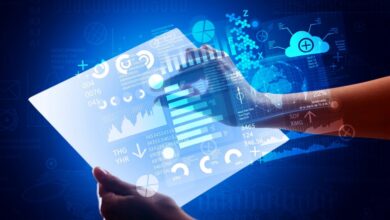What is Synthetic Data?
Synthetic data refers to information that has been manufactured consciously rather than as a result of actual events. It is generated algorithmically, used to create test data sets for production or operational data, and used to train machine learning models.
While it is challenging, expensive, and time-consuming to collect high-quality data from the real world, synthetic data technology enables users to quickly, easily, and digitally synthesize the data in whatever amount they choose, tailored to their particular needs.
What is Synthetic Data vs. Real Data?
Contrarily, digital surroundings produce artificial data. Except for the portion that was not derived from any actual events in the real world, these data were created in a method that successfully mimics the genuine data in terms of fundamental features. The possibility of using synthetic data as an alternative to actual data is very promising because it is possible to simply produce the training data needed for machine learning models. The substantial benefits that synthetic data has to provide are unaffected by this.
Real-world and synthetic data differ significantly in many important ways. Real data is often small, hard to acquire, and might not accurately represent all potential values or behaviors, making it challenging to manage and analyze. In comparison, synthetic data may be produced in bigger volumes and with more accuracy to fulfill individual needs. It is also considerably more versatile and simple to retrieve.
In addition, as synthetic data does not include any personally identifying information and cannot be readily reverse-engineered to retrieve sensitive information, it is more privacy-compliant than real data. In general, synthetic data is a potent tool for organizations that require access to high-quality datasets but lack the resources or must maintain the privacy of their data.
What is an Example of Synthetic Data Generation?
To enhance AI models, safeguard sensitive data, and reduce bias, synthetic data is information that has been manufactured on a computer to supplement or replace genuine data. Information overload occurs when a human is exposed to a firehouse of data.
Examples of applications using synthetic data include the following: media information. In this use case, artificial visuals, audio, and video are produced using computer graphics and image processing algorithms.
What is Synthetic Data in Artificial Intelligence?
In addition to lowering expenses, synthetic data can allay privacy worries relating to potentially sensitive data obtained from the real world. It might help minimize prejudice compared to actual data, which might not accurately reflect the whole range of facts about the real world. Synthetic data can offer more variety by presenting uncommon events that represent conceivable possibilities but may be difficult to obtain from authentic data.
It can also be a useful tool for modeling and creating data that doesn’t exist in the real world by changing the parameters. Understanding markets and trends in finance is essential. Making solid planning and forecasts in front of a potential financial crisis may be possible with the help of modeling.
As ‘what if’ situations can be reflected in synthetic test data, it is the perfect tool for testing theories and simulating multiple outcomes. Yes, synthetic data can replace real-world records with greater accuracy and scalability. But it goes beyond that. To feed the models that will have an impact on how we all live in our data-driven future, data scientists can perform novel, inventive things with synthetic data that are not achievable with just real-world data.
Is Synthetic Data Fake Data?
What does Synthesize Data Mean?
What is another word for Synthetic Data?
You can use ‘fabricated information’ in place of ‘synthetic data
What does Synthesize Data Mean?
In the systematic review process, the stage of synthesis or synthesizing data means where the gathered data and the conclusions of many studies are compiled and assessed. The review’s conclusions will be decided upon during the synthesis phase. The various methods for preparing data for analysis are shown below, along with the situations in which each method is most useful.
-
Computations
You can make new data points from the raw data using calculations. Take note that everyone should use the same set of raw data for computations so that it is clear who is using the correct number and where the data comes from.
-
Summarizations
Data from several organizational departments are combined in aggregates. For instance, you may add up the sales figures from each of your regions to determine your overall sales figure. As a result, you can view the big picture while simultaneously drilling down into the specifics as necessary.
-
Charts and Visualizations
Data can be represented in charts in a huge variety of ways. Although some people enjoy viewing raw data, it can be challenging to grasp the big picture when only viewing a data table.
-
Regression Lines
You can view data averages and the trends in a certain series using regression lines.
What is a Synthetic Database?
While all CID is eliminated during the process, the database’s organizational structures will be retained in the final picture. The outcome is a realistic environment that resembles a production setting and functions just like the original database. It is better than all existing methods, even those as straightforward as artificial databases or basic anonymization.
It used to be recommended practice for banks to create a copy of their production data before developing and testing new software. The use of productive data has a cost, even though it enables the development of trustworthy solutions and results in test findings that are believable. Access to CID is highly constrained by compliance. This places restrictions on the participation of internal developers and, to a greater extent, outside providers. The compliance issue is resolved by the existing solutions for this problem, notably fake or anonymized databases. Artificial databases, however, are frequently tiny in size, with little diversity and complexity, providing a partial mirror of the productive data while still requiring a lot of upkeep.
How do you make Synthetic Data from Real Data?
If you have less, your synthetic data might not pass the platform’s privacy test after the process of creating synthetic data. Your data subjects are safeguarded by automatic privacy protection procedures, so you won’t acquire anything potentially hazardous.
Synthetic Data Could be better than Real Data?
Advocates contend that by filling in the gaps in datasets more quickly and inexpensively than real-world collecting, synthetic data can get around problems like high production and maintenance costs, a lack of real-world data available for training, and social and other biases.
Who Creates Synthetic Data?
Types of Synthetic Data
Knowing the kind of synthetic data needed to address a business challenge is crucial when choosing the best approach for producing it. The two types of synthetic data are fully synthetic and partially synthetic.
• Partially synthetic data keeps all the information from the original data except for the sensitive information, demonstrating that all the necessary variables are present but the data is not recognizable. The true values occasionally are likely to persist in the carefully curated synthetic data collection because it is retrieved from the real data.
Several other types of synthetic data serve different purposes.
-
Synthetic Text
Text created artificially is referred to as synthetic text. To generate text, you build and refine a model. Because of the intricacy of languages, accurate synthetic writing has always been challenging to produce. However, the development of extremely effective natural language production systems was made possible by the introduction of new machine learning models.
-
Synthetic Images and Videos
A synthetic piece of data can also be a faked video, image, or sound. You produce media with traits that are eerily similar to information from the actual world. Fake media can easily replace real data due to their similarities.
-
Tabular Synthetic Data
Synthetic data that is stored in tables but is generated artificially is referred to as tabular synthetic data. There are columns and rows of data here. Any number of things, such as a patient database, data on users’ analytical behavior, or financial records, could be included.
Synthetic Data Generation Techniques
-
Based on the Statistical Distribution
In this method, numbers must be drawn from the distribution by looking at genuine statistical distributions; comparable factual data must be replicated. You can use this true data in some circumstances where real data is not accessible.
A data scientist can construct a dataset with a random sample of distribution if he or she has a thorough understanding of the statistical distribution of real data. The data scientist’s proficiency with this technique has a significant impact on how accurate the trained model is.
-
Based on an Agent to Model
Using this technique, you can build a model that explains observed behavior and then use that model to generate random data. In this case, actual data are being fitted to the data’s known distribution. Businesses can create synthetic data using this technique.
Other machine learning techniques can also be applied to fit the distributions. However, the decision tree will overfit when the data scientist wishes to make future predictions because of its simplicity and full depth. Additionally, in some circumstances, you can see that some of the actual data is accessible.
-
Using Deep Learning
Methods for creating fake data are used in deep learning models that use a variational auto encoder or a generative adversarial network model. VAEs are a class of unsupervised machine learning models that include encoders to compress and compact the actual data while decoders analyze this data to represent the actual data. Making sure that input and output data remain remarkably identical is the fundamental goal of employing VAE.
Synthetic Data Generation Tools
-
GenRocket
The pioneer in artificial data creation for quality engineering and machine learning use cases is GenRocket. The next evolution of test data management is what we refer to as synthetic test data automation (TDA).
-
Datomize
Datomize has a machine learning or artificial intelligence model that is mostly employed by top-tier banks worldwide. You may quickly link your enterprise data services with Datomize and handle high-intensity data structures and dependencies using various tables. Using this approach, you may build identical data twins of the original data and extract behavioral aspects from the raw data.
-
MOSTLY.AI
It is a tool for producing synthetic data that enables AI and high-priority privacy while also extracting patterns and structures from the original data to produce whole new datasets.
-
Synthesized
This tool creates various iterations of the original data and tests them using a variety of test data. This aids in locating sensitive data and identifying the values that are missing.
-
Rendered
Rendered by AI. Artificial intelligence creates physics-based synthetic datasets for autonomous vehicles, robotics, healthcare, and satellites. Engineers can quickly make changes and perform analyses on datasets with this no-code setup tool and API. Data generation can be done in the browser, making it simple and low-resource to operate ML workflows.
-
Oneview
This technique will aid object detection even when there are blurry photos or lower resolutions while using mobile devices, satellites, drones, and cameras. It will offer precise and thorough comments on digitally produced images that closely resemble the real world.
-
MDClone
MDClone is a specialized instrument that is mostly used in healthcare organizations to produce a tone of patient data that will enable the sector to use the data for individualized care. However, the method was cumbersome and slow, and researchers had to rely on mediators to acquire clinical data.
-
Hazy
Hazy is a tool for creating synthetic data that attempts to train unprocessed banking data for fintech sectors. Preventing fraud while gathering actual consumer data will enable the developers to accelerate their analytics workflows. During the generation of financial services, sophisticated data can be produced and stored in firm silos. Real financial data sharing, however, is tightly constrained and regulated by the government.
-
Sogeti
This cognitive-based tool aids in the synthesis and processing of facts. ADA distinguishes itself by using deep learning techniques to simulate recognition abilities.
-
Gretel
It is a tool designed exclusively for producing synthetic data. It is a self-described program that creates statistically similar datasets without revealing any private information about the source’s customers. A sequence-to-sequence model is used to compare the real-time data while the data synthesis model is being trained to enable prediction while producing fresh data.
-
CVEDIA
CVEDIA offers synthetic computer vision solutions for enhanced object recognition and AI rendering. It is jam-packed with various machine language algorithms. It is utilized for many different tools, IoT services, and the creation of sensors and AI applications.
-
Rendered
Rendered by AI. Artificial intelligence creates physics-based synthetic datasets for autonomous vehicles, robotics, healthcare, and satellites. Engineers can quickly make changes and perform analyses on datasets with this no-code setup tool and API. Data generation can be done in the browser, making it simple and low-resource to operate ML workflows.
-
Oneview
This technique will aid object detection even when there are blurry photos or lower resolutions while using mobile devices, satellites, drones, and cameras. It will offer precise and thorough comments on digitally produced images that closely resemble the real world.
-
MDClone
MDClone is a specialized instrument that is mostly used in healthcare organizations to produce a tone of patient data that will enable the sector to use the data for individualized care. However, the method was cumbersome and slow, and researchers had to rely on mediators to acquire clinical data.





I have recently started a site, the info you offer on this web site has helped me tremendously. Thanks for all of your time & work.